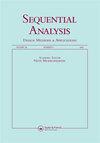A general theory of purely sequential minimum risk point estimation (MRPE) of a function of the mean in a normal distribution
IF 0.6
4区 数学
Q4 STATISTICS & PROBABILITY
Sequential Analysis-Design Methods and Applications
Pub Date : 2019-10-02
DOI:10.1080/07474946.2019.1686885
引用次数: 7
Abstract
Abstract A purely sequential minimum risk point estimation (MRPE) methodology with associated stopping time N is designed to come up with a useful estimation strategy. We work under an appropriately formulated weighted squared error loss (SEL) due to estimation of a function of μ, with plus linear cost of sampling from a population having both parameters unknown. A series of important first-order and second-order asymptotic (as c, the cost per unit sample, ) results is laid out including the first-order and second-order efficiency properties. Then, accurate sequential risk calculations are launched, which are then followed by two main results: (i) Theorem 4.1 shows an asymptotic risk efficiency property, and (ii) Theorem 5.1 shows an asymptotic second-order regret expansion associated with the proposed purely sequential MRPE strategy assuming suitable conditions on g(.). We also provide a bias-corrected version of the terminal estimator, We follow up with a number of interesting illustrations where Theorems 4.1–5.1 are readily exploited to conclude an asymptotic risk efficiency property and second-order regret expansion, respectively. A number of other interesting illustrations are highlighted where it is possible to verify the conclusions from Theorems 4.1–5.1 more directly with less stringent assumptions on the pilot sample size.正态分布中均值函数的纯序列最小风险点估计的一般理论
摘要设计了一种具有关联停止时间N的纯序列最小风险点估计方法,提出了一种实用的最小风险点估计策略。我们在一个适当的公式加权平方误差损失(SEL)下工作,这是由于对μ函数的估计,加上从两个参数都未知的总体中采样的线性代价。给出了一系列重要的一阶和二阶渐近结果(如单位样本成本c),包括一阶和二阶效率性质。然后,进行了精确的序列风险计算,然后得到两个主要结果:(i)定理4.1显示了渐近的风险效率性质,(ii)定理5.1显示了与所提出的纯序列MRPE策略相关的渐近二阶遗憾展开式,假设g(.)上的合适条件。我们还提供了一个偏差修正版本的终端估计器,我们随后提供了一些有趣的插图,其中定理4.1-5.1很容易被利用来分别得出渐近风险效率性质和二阶遗憾展开。许多其他有趣的插图被突出显示,在这些插图中,可以更直接地验证定理4.1-5.1的结论,对试点样本量的假设不那么严格。
本文章由计算机程序翻译,如有差异,请以英文原文为准。
求助全文
约1分钟内获得全文
求助全文
来源期刊

Sequential Analysis-Design Methods and Applications
STATISTICS & PROBABILITY-
CiteScore
1.40
自引率
12.50%
发文量
20
期刊介绍:
The purpose of Sequential Analysis is to contribute to theoretical and applied aspects of sequential methodologies in all areas of statistical science. Published papers highlight the development of new and important sequential approaches.
Interdisciplinary articles that emphasize the methodology of practical value to applied researchers and statistical consultants are highly encouraged. Papers that cover contemporary areas of applications including animal abundance, bioequivalence, communication science, computer simulations, data mining, directional data, disease mapping, environmental sampling, genome, imaging, microarrays, networking, parallel processing, pest management, sonar detection, spatial statistics, tracking, and engineering are deemed especially important. Of particular value are expository review articles that critically synthesize broad-based statistical issues. Papers on case-studies are also considered. All papers are refereed.
 求助内容:
求助内容: 应助结果提醒方式:
应助结果提醒方式:


